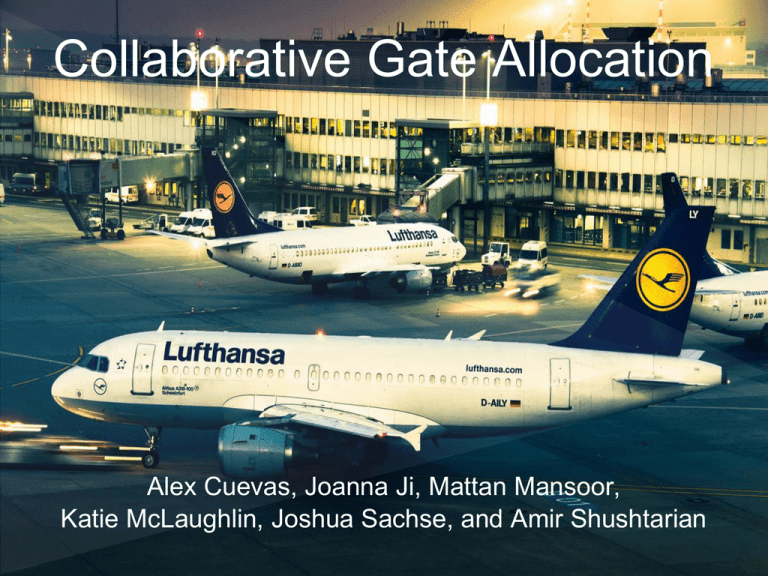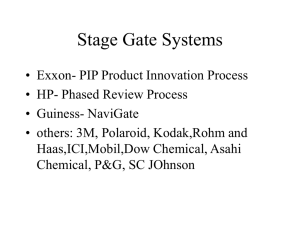Collaborative Gate Allocation
advertisement

Collaborative Gate Allocation Alex Cuevas, Joanna Ji, Mattan Mansoor, Katie McLaughlin, Joshua Sachse, and Amir Shushtarian Agenda 1. Introduction 2. The Need for Collaboration 3. Possible Scenarios 4. Economics and Feasibility 5. Simulation Model 6. Recommendation & Next Steps What is CGA? Collaborative Gate Allocation is a dynamic model of a new, more efficient policy to help reach the system optimum of gate use and allocation. Requires data sharing and collaboration from Airlines Airport operators FAA Communities The Need for CGA Analysis of Major Players Major Player Primary Interests Preferred Method of Collaboration Main Opportunity Presented by CGA Airports - Maximize Revenue - Run efficiently - Full or partial collaboration - Increased utilization of gates without infrastructure investments Airlines - Maximize control of gates - Keep other airlines from obtaining gates -Minimize delays - Alliances or minimal collaboration (overflow only) - Reduced delays and fuel burn savings - Increased collaboration among airlines FAA - Safety - Efficiency - Full or partial collaboration - Reduced congestion of ramp areas and thus fewer accidents Communities - Minimize pollution - Minimize noise - Full collaboration - Less carbon emissions and pollution from fewer gate delays Once we convince airlines (through financial and environmental arguments) that gate sharing is mutually beneficial, airlines should be more receptive to change and more willing to collaborate Scenario 1: Airports control shared gates Airport keeps portion of the gates, and allocates them to airlines facing gate constraints during their peak hours. Advantages: 1. Airlines keep the control of majority of the gates 2. Decreases gate leasing costs for airlines 3. Does not require airline cooperation! Disadvantages: 1. Airport must get involved in gate allocation process 2. Encourages over-scheduling to gain more shared gate slots 3. Many gates are under long-term leases Scenario 2: Airlines share gates Airlines cooperate with each other and rent extra gates to airlines in need. Advantages: 1. Does not require Airports to get involved 2. Airlines benefit from less delays due to shortage of gates and income from renting extra gates 3. Requires minimal modifications to leasing agreements Disadvantages: 1. Shared gates must be standardized to serve all airlines 2. Airlines may not cooperate equally with each other Scenario 3: Airlines pool gates Hybrid of both previous methods. Airlines create pool of gates that they are willing to share with other airlines. Advantages: 1. Does not require Airport to get involved in the process 2. Decreases gate leasing costs for airlines 3. Fewer gates to standardize 4. Requires minimal changes to previous lease agreements 5. Increases service efficiency compared to other methods Disadvantages 1. Larger airlines may not participate 2. Encourages over-scheduling to gain more shared gate Economics of CGA • • • New terminals: 40% of capital investments Average cost of a delayed flights exceeds profit from flight. Estimated 3-5% increase in capacity, allowing for increased density of scheduling and throughput. Economic Deterrents • • • Reduces oligopolistic advantage of larger airlines Requires implementation and interfacing with individual airline allocation systems Requires increased mobility of ground operations Economics Incentives • • Reduced delays o Increased Predictability o • • Lowers costs to passengers and airlines Leads to increased Capacity through tighter scheduling Minimal capital investment and land requirements Increases competitiveness of smaller airlines Gate Allocation (GA) Model Need quantitative results! • • • Computer model to simulate GA scenarios Cost and benefit analysis based on airport-specific parameters Present findings to airport and airlines for negotiations Gate Allocation (GA) Model CGA group FAA Airlines Gate Allocation (GA) Model GA model in Java Object oriented approach Data parser Gate assignment is NP-Hard • • • o o • o Large inputs can't be solved Use greedy algorithm + heuristics Adjustable precision based on CPU Formatted output data Gate Allocation (GA) Model • • Takes flight schedules as input o o • • Flight schedule = list of flights Flight (aircraft type, alliance affiliation, arrival t, departure t) Takes parameters (e.g. desired buffer times, # of shared gates) Applies random delays and recalculates approximation of optimal gate mapping GA Flowchart Parameters + Scenario Flight Schedule Delay Gate Mapping Gate Allocation Algorithm Flight Schedule Gate Mapping Gate Allocation (GA) Model Methodology: 1. Choose target airport 2. Determine set of scenarios a. Allocation algorithm b. Alliance configuration c. Collaborative gate configuration 3. Run GA algorithm 4. Run CBA on results 5. Compile and present Results! Work in Progress Other Potential Scenarios 1. Complete Collaboration • All airlines are required to participate 1. Partial Collaboration • Airlines can opt in if they see a benefit 1. Alliance Collaboration • Global Alliances can work together • Airport-Specific Alliances of all small players against one large player can be formed Recommendation & Next Steps - CGA will function only if all players are willing to collaborate. - Continue developing model for a more wellrounded recommendation







